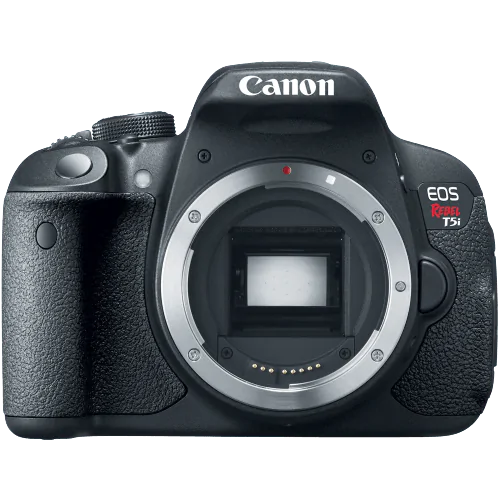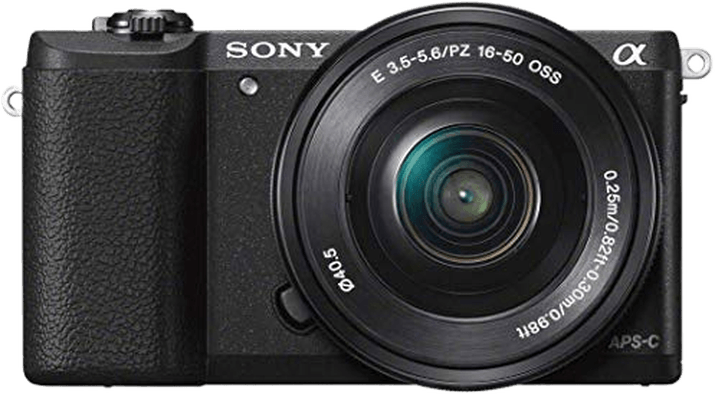Canon EOS Rebel T5i / 700D vs Sony a5100 Comparison
Canon EOS Rebel T5i / 700D

Sony a5100

The Sony a5100 outperforms the Canon EOS Rebel T5i / 700D with a score of 60/100, while the Canon scores 44/100. Both cameras share similarities like their announcement dates in 2013 and 2014, and their respective launch prices of $750 and $550.
The Sony a5100 holds the advantage with its mirrorless design, resulting in a smaller size (110 x 63 x 36mm) and lighter weight (283g / 0.62lbs) compared to the Canon’s DSLR build (133 x 100 x 79mm and 580g / 1.28lbs). This makes the Sony a5100 a more portable option.
On the other hand, the Canon EOS Rebel T5i / 700D, being a DSLR, could potentially offer better image quality and performance in specific situations. However, the lower score indicates that it might not be the case for this particular model.
Considering these factors, the Sony a5100 proves to be a better choice for those prioritizing portability and compactness, while the Canon EOS Rebel T5i / 700D could be an option for those who prefer a DSLR, despite its lower score.
Canon EOS Rebel T5i / 700D vs Sony a5100 Overview and Optics
The Sony a5100 outperforms the Canon EOS Rebel T5i / 700D in optics, scoring 66 points compared to the Canon’s 40 points. Both cameras share several specifications, including a CMOS sensor, APS-C sensor size, and a lack of image stabilization. However, the Sony a5100 excels in certain areas, making it the superior choice in terms of optics.
The Sony a5100 boasts a higher resolution with 24.3 megapixels, compared to the Canon T5i’s 18 megapixels. This allows the Sony camera to capture more detail in images. Additionally, the Sony a5100 has a faster shooting speed of 6 frames per second, while the Canon T5i only manages 5 frames per second. The Sony a5100’s Bionz X processor contributes to its better performance, as demonstrated by the DXOMARK score for the sensor, which is 80 for the Sony and 61 for the Canon.
On the other hand, the Canon T5i has the advantage of a Canon EF-S lens mount, which offers a wider range of compatible lenses. This could be beneficial for photographers who already own Canon lenses or prefer the selection available in the Canon ecosystem.
Considering the higher resolution, faster shooting speed, and better sensor performance, the Sony a5100 is the clear winner in terms of optics. The Canon T5i’s main advantage lies in its lens mount compatibility, but this may not be enough to sway potential buyers. Therefore, the Sony a5100 is the recommended choice for those prioritizing optical performance.
Canon EOS Rebel T5i / 700D vs Sony a5100 Video Performance
The Sony a5100 outperforms the Canon EOS Rebel T5i / 700D in terms of video capabilities, with a video score of 56/100 compared to the Canon’s 43/100. Both cameras share some common specifications, such as having a maximum video resolution of Full HD and dimensions of 1920 x 1080. Additionally, neither camera has built-in time-lapse functionality.
The winning camera, the Sony a5100, offers a higher maximum video frame rate of 60fps, which is double the Canon T5i / 700D’s 30fps. This higher frame rate allows the a5100 to produce smoother videos and capture fast-moving action with greater detail.
Although the Canon T5i / 700D has a lower video score and a lower maximum frame rate, it may still be a suitable option for those who do not require high frame rates for their video recording needs. In this case, the T5i / 700D’s video capabilities may be sufficient for casual users or those on a tighter budget.
Taking all factors into consideration, the Sony a5100 is the better camera for video recording due to its higher video score and superior maximum frame rate. The Canon EOS Rebel T5i / 700D, while not as strong in video capabilities, may still be a viable option for those with less demanding video requirements.
Canon EOS Rebel T5i / 700D vs Sony a5100 Features and Benefits
The Canon EOS Rebel T5i / 700D wins the features comparison with a score of 57 out of 100, while the Sony a5100 scores 54. Both cameras have a 3-inch screen, touchscreen capabilities, a flip screen, and no GPS or Bluetooth. However, the Canon T5i has a higher screen resolution with 1,040,000 dots compared to the Sony a5100’s 921,600 dots. This difference gives the Canon T5i a better display quality.
The Canon T5i’s advantage lies in its screen resolution, which provides clearer and sharper images when reviewing photos or navigating the menu. This higher resolution makes it easier for photographers to check their images’ focus and quality, ensuring they capture the best possible shots.
On the other hand, the Sony a5100 has built-in Wi-Fi, a feature not present in the Canon T5i. This allows users to transfer images wirelessly, control the camera remotely, and share photos instantly to social media platforms. This connectivity feature gives the Sony a5100 an edge, especially for photographers who prioritize convenience and quick sharing.
Taking these factors into account, the Canon T5i’s superior screen resolution makes it the better choice for those who need a clearer display for image review and menu navigation. However, the Sony a5100’s Wi-Fi capabilities make it more suitable for photographers who value instant sharing and wireless control.
In the end, the Canon EOS Rebel T5i / 700D and the Sony a5100 have their strengths and weaknesses. The choice depends on the photographer’s priorities and preferences, whether it’s display quality or connectivity features.
Canon EOS Rebel T5i / 700D vs Sony a5100 Storage and Battery
The Canon EOS Rebel T5i/700D and the Sony a5100 both have a storage and battery score of 24/100. They share common specifications, such as one memory card slot each and compatibility with SD/SDHC/SDXC memory cards. Neither camera has USB charging capabilities.
The Canon T5i/700D edges out the Sony a5100 in battery life, providing 440 shots compared to the a5100’s 400 shots. The T5i/700D uses an LP-E8 battery, which contributes to its longer battery life. This advantage makes the Canon camera more suitable for extended shooting sessions.
On the other hand, the Sony a5100 accepts additional memory card formats, including Memory Stick Pro Duo and Pro-HG Duo, providing more storage options for users. This flexibility can be beneficial for those who already own these memory cards or require different storage options.
Both cameras have their strengths and weaknesses in terms of storage and battery. The Canon T5i/700D offers better battery life, while the Sony a5100 provides more storage options. Users should consider their specific needs and preferences when choosing between these two cameras.
Alternatives to the Canon EOS Rebel T5i / 700D and Sony a5100
Are you still undecided about which camera is right for you? Have a look at these popular comparisons that feature the Canon EOS Rebel T5i / 700D or the Sony a5100:

